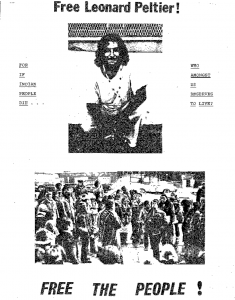In honor of November being American Indian and Alaska Native Heritage Month, this week’s post will be focusing on the history of the American Indian Movement (AIM). Although activism in the American Indian community had been occurring before the establishment of AIM, the movement gained significant attention and was instrumental in using the news media to spread their message and activism.
Founded in July 1968 in Minneapolis, Minnesota, the group was initially formed to address Native American treaty issues, racism, police harassment, and to achieve economic independence and sovereignty for Native American people. Other areas of focus were spirituality, affirmation, and leadership for the American Indian and Alaska Native community. Rather than focusing on traditional lobbying strategies, AIM members chose to take their message directly to the American public by holding events, creating their own press through the use of zines and other newsletters, and its leaders often sought out opportunities for the explicit purpose of creating more visibility for the movement.
From its inception in 1968, AIM members led protests, sit-ins, and other forms of public activism to gain visibility and attention from the larger American public toward the plight of the American Indian. In 1970, around Thanksgiving, members seized a replica of the Mayflower; in 1971, members occupied Mount Rushmore, which was carved into the mountainside of sacred Lakota land. Also in 1971, members also occupied the Bureau of Indian Affairs (BIA) building in Washington, D.C., citing the poor management and problems with the administration for their treatment of Native Americans and reservations.
AIM, in their 20 point list to summarize issues with federal treaties and promises, had twelve points directly related to treaty responsibilities that the U.S. government had failed to fulfill and uphold. In 1972, AIM members and other Indian groups gathered together for a protest named “The Trail of Broken Treaties” in Washington, D.C. Their high visibility, achieved through events like protests, occupations, and other forms of activism, gave the members a platform but also made the movement a target for government intervention. What AIM is probably best known for in current times are the events that occurred at Pine Ridge Indian Reservation at Wounded Knee, where around 200 to 300 AIM activists and FBI agents were in an armed stand-off for 71 days in 1973.
Following the Wounded Knee incident, violence and deaths abounded within the AIM community with suspicions of members being FBI informants and garnered significant media attention to the protest. Notably, in 1973 during the Academy Awards, Marlon Brando refused to attend the event and in his place sent Sacheen Littlefeather, a Native American actress, to accept his award and to use the platform to speak about the movement. During the occupation of Wounded Knee, activists Dennis Banks and Russell Means were often the spokespersons for the organization, and the motivation for going to Pine Ridge was due to the high levels of poverty, the tribal chairman Richard Wilson’s corrupt activities, and failure of the U.S. government to uphold its end of the treaties. Wilson’s supporters, known as Guardians of the Oglala Nation (GOONs), are believed to have murdered 60 opponents of the tribal government.
Despite the protests, Wilson was re-elected in 1974 amid voter corruption scandals, intimidation, and other means of coercing the election in his favor. Violence on the reservation erupted during this time between opponents of his presidency and his supporters. Means and Banks were indicted by the South Dakota government for their participation in the occupation and protest, which later was ruled a mistrial with all charges being dropped against them. However, Leonard Peltier, another member of AIM, was arrested and imprisoned in 1975 following a shootout with two FBI agents on the reservation. Peltier has long maintained his innocence and was most recently denied clemency by the Obama administration. He is currently still in prison.
The movement continues to exist today and has grown to encompass a number of other organizations all focused on the same issues. At Michigan State University, there are materials in the radicalism special collection from the early days of AIM (accesible through SiRO), and a number of other resources exist for scholars and other interested persons to learn more about the movement and its impact.
Resources
University of Minnesota American Indian Movement Archives and Records
Michigan State University Radicalism Collection – American Indian Movement
Smithsonian Institution – American Indian Movement
Digital Public Library of America – AIM
GALE – AIM and Native American Radicalism
